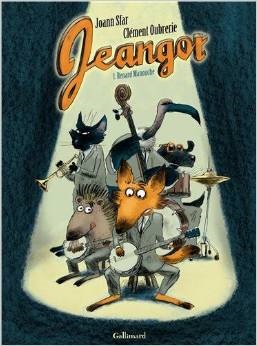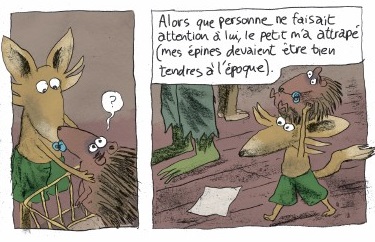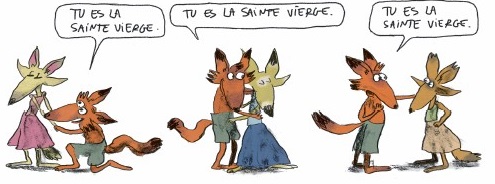Review: 'Jeangot. T.1, Renard Manouche', by Joann Sfar & Clément Oubrerie
 Once again, I owe thanks to Lex Nakashima for ordering this from France and loaning it to me to write this review for Flayrah.
Once again, I owe thanks to Lex Nakashima for ordering this from France and loaning it to me to write this review for Flayrah.
Joann Sfar is probably best-known in the furry community as the author of Le Chat du Rabbin/The Rabbi’s Cat (art by Antoine Delesvaux); the 2003-2006 five-album bandes dessinés, and especially the 2011 animated feature which he directed, released in the U.S. in 2013, featuring a talking cat in Algiers in the 1920s.
Sfar has written other unusual anthropomorphic comics drawn by other artists, such as the 2003-2009 three-volume Socrates the Half-Dog/Socrate le Demi-Chien with art by Christophe Blain, about Héraclès’ semi-divine dog in mythological ancient Greece. In Jeangot, Sfar has begun a new, all-funny-animal cartoon-art series, drawn by Clément Oubrerie, that carries “bizarreness” to a new extreme.
Paris, Éditions Gallimard, November 2012, hardcover €14.50 (54 pages).
At first it seems to be a biography of the 1930s-‘40s gypsy fox musician Jeangot Renart, being written by his pal Niglaud the hedgehog in his old age. Niglaud was Jeangot’s lifelong pal and musical partner, so he knows all of the details.

My name is Niglaud. I was born in 1910 in a willow cage, in a caravan wagon parked somewhere in Belgium, belonging to the Renart family.
In Jeangot, Sfar focuses upon the life of gypsies in northwestern Europe between the two World Wars. The title of volume 1, Renard Manouche, is “The Gypsy Fox”. Niglaud explains that while most farmers raise chickens to eat, wandering gypsies prefer hedgehogs because they are easy to catch in the fields. What is different about him is that the Renarts raised caged hedgehogs in their travelling wagon. Niglaud was born at the same time as the Renarts’ own son, and he became the playmate of Jeangot, which is why he wasn’t eaten.
Although the background and art are anthropomorphic, the dialogue is not very. In an early scene, Mrs. Renart is talking with another gypsy just after Jeangot’s birth.
Narrator: Madame Renart brought into the world a boy that cried very loudly who she baptized ‘Jeangot’.
“Jeangot? That’s not a gypsy name.”
“No … it’s French. If he ever wants to be President of the Republic, it’s better to have a French name. Even in Belgium.”
“Yeah.”
“Besides, it’s better for the police.”
Narrator: Then his father arrived, with his drunken pals. And they began to celebrate little Jeangot’s birth.
The life of a European gypsy at the beginning of the 20th century was so exotic that it seemed made for funny-animal fantasy.
The advantage of traveling homes is that they travel. We wandered a lot at that time because when we stayed too long in one place, the locals kicked us out. So we went to the South … to Italy … to Corsica … and when the World War broke out, we went to the Arabs [North Africa]. Where there was plenty of sun and nobody was trying to kill us.
In November 1918, the war ended and the gypsies returned to Europe. By then Jeangot and Niglaud were old enough to leave home (an advantage of being gypsies), and they parleyed growing up as street musicians during the 20s into joining a jazz band in Paris as young adults around 1930.
From here (page 14), Jeangot turns into a funny-animal novel about life in the Bohemian world of French gypsy jazz, based very loosely on the biography of Django Reinhardt. Wikipedia says:
Gypsy jazz (also known as gypsy swing or hot club jazz) is a style of jazz music often said to have been started by guitarist Jean ‘Django’ Reinhardt in the 1930s. Because its origins are largely in France it is often called by the French name, ‘jazz manouche’, or alternatively, ‘manouche jazz’, even in English language sources. Some modern dictionaries recommend avoiding using the word ‘gypsy’ because it is felt to have been tainted by its frequent use as a pejorative, however dictionaries do not caution against use of the term ‘gypsy jazz.’
Django was foremost among a group of Romani guitarists working in and around Paris in the 1930s through the 1950s, a group which also included the brothers Baro, Sarane, and Matelo Ferret and Reinhardt's brother Joseph "Nin-Nin" Reinhardt.
Jeangot is broadly similar to Robert Crumb’s Fritz the Cat, including the NSFW stuff like a rabbit whore. But about halfway through (please excuse the spoiler), Jeangot is suddenly almost killed and practically disappears from the book.
 From there on, it becomes obvious that Niglaud has been writing Jeangot’s biography. He pads it with his own autobiography – he is a much more interesting character once he stops living in Jeangot’s shadow – and the present, old-age Niglaud gets into violent arguments with his would-be publisher over whether his manuscript is saleable or not. By this point, Niglaud appears to be suffering from some old-age dementia, with his more recent memories of Jeangot clearly a fantasy. In fact, it is unclear whether Jeangot is alive or whether he died a long time ago. Does Niglaud really have a publisher, or is he like Charles Schulz’s Snoopy, convinced that he has written a best-seller that he really can’t interest any publisher in?
From there on, it becomes obvious that Niglaud has been writing Jeangot’s biography. He pads it with his own autobiography – he is a much more interesting character once he stops living in Jeangot’s shadow – and the present, old-age Niglaud gets into violent arguments with his would-be publisher over whether his manuscript is saleable or not. By this point, Niglaud appears to be suffering from some old-age dementia, with his more recent memories of Jeangot clearly a fantasy. In fact, it is unclear whether Jeangot is alive or whether he died a long time ago. Does Niglaud really have a publisher, or is he like Charles Schulz’s Snoopy, convinced that he has written a best-seller that he really can’t interest any publisher in?
This volume 1 ends with a note that the story will be continued in Music is for the Ears, but I can’t imagine where Sfar can take it next. Jeangot is certainly intriguing -- there is nothing else quite like it.
About the author
Fred Patten — read stories — contact (login required)a retired former librarian from North Hollywood, California, interested in general anthropomorphics
Comments
Post new comment